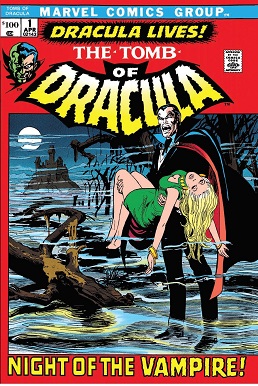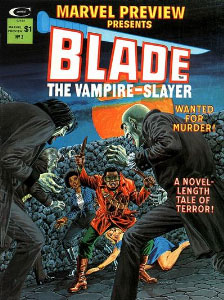When he first appeared in 1973, Blade stood out as a memorable supporting character in the Marvel comic The Tomb of Dracula. But over time, the vampire hunter took on greater significance and prominence. By the end of the 1990s, Blade would headline the first successful feature film starring a Marvel character, laying the groundwork for the blockbusters that followed. Today, with a new film on the way starring Academy Award winner Mahershala Ali, Blade is bigger than ever. Here’s the story of how a background character stole the spotlight and managed to find his own form of eternal life.
Blade first appeared in an era when two distinct cultural shifts were affecting American comics. One was the return of horror characters to the pages. After the Congressional hearings of the 1950s that essentially destroyed horror publisher EC Comics, the other publishers agreed to submit their books to a set of rules governed by the Comics Code Authority. Those rules initially banned horror content completely. In 1971, Stan Lee wanted to tell an anti-drug story in three issues of The Amazing Spider-Man, but the CCA tried to forbid it. Lee convinced Marvel to go ahead and do the story, forgoing the CCA seal. In response, the CCA relaxed their rules, including the ban on horror characters. Marvel and their crosstown rival, DC Comics, immediately jumped back into the horror game, leading to the debut of characters like Ghost Rider, Morbius, and Werewolf by Night at Marvel and Swamp Thing and Etrigan the Demon at DC.
At roughly the same time, beginning in 1970, the “Blaxploitation movement” in cinema led to a boom in action and horror films featuring Black directors, actors, and writers; most notable was Shaft and its Oscar-winning “Theme from Shaft.” In comics, the number of Black characters started to grow. While Black Panther and Falcon already existed at Marvel, the decade would see the introduction of characters like Luke Cage and Black Goliath at Marvel and Black Lightning at DC.

As part of their return to horror, Marvel launched a comic book series featuring Dracula. The penciler assigned to the series was Gene Colan, a fan favorite for his lengthy run on Daredevil and the co-creator of Falcon and Carol Danvers (who would later become Ms. Marvel, then Captain Marvel). Tom Palmer boarded as inker. The writer’s desk was a little harder to nail down; the series eventually found its permanent writer in Marv Wolfman.

Wolfman, a white, Jewish man who grew up in New York, drank in his multicultural surroundings and was struck by the fact that Black people were underrepresented in comics. That opportunity came with Tomb of Dracula #10, the July 1973 issue, when Vampire hunter Blade debuted on the cover. Wolfman and Colan based his appearance on an amalgam of Black actors, but notably Jim Brown, the NFL legend, activist, and star of films like The Dirty Dozen. Two other prominent visuals appear on that cover as well: Blade’s safari jacket (which over time would give way to a leather duster) and his bandolier of weapons.
In an already interesting cast populated with vampire hunters who were related to characters from the original novel (Rachel Van Helsing, Quincy Harker, Frank Drake), Blade stood out both because of his appearance and because of his attitude. Wolfman knew that; in interviews, he has noted that he consciously downplayed Blade for a while because he didn’t want him to overshadow the others. Within a year, Blade was getting solo stories in anthology books like Marvel Preview and Marvel’s black and white horror magazine Vampire Tales.

Tomb of Dracula had an acclaimed 70-issue run and has been favorably viewed by comics critics and historians as one of Marvel’s best books of the 1970s. The series concluded in 1979 with Dracula’s apparent destruction, but the Count and his supporting cast would pop up in Marvel titles over the next few years (for example, Blade was present in 1983’s Doctor Strange #62 when Dracula and all of Earth’s vampires were destroyed by a spell called the Montesi Formula). With vampires seemingly gone, Blade, as well as other Marvel horror characters who had suffered from waning sales, took much of the rest of the ’80s off.
The horror characters came back in a big way at Marvel in 1990 when a new Ghost Rider series caught fan attention. The publisher had a proven track-record of building franchises around teams like the X-Men and the Avengers; this time, they decided to build a franchise around their horror characters. This loosely affiliated team was called the Midnight Sons and initially included Blade (now decked out in his familiar black ensemble), Ghost Rider, Doctor Strange, Morbius, and others. Blade got even more visibility when the character showed up on the popular Spider-Man animated series on Fox. Furthermore, plans were already afoot to get the vampire slayer on the big screen.
Before he was a TV fixture on shows like In the House and NCIS: Los Angeles, hip-hop legend LL Cool J worked on making a Blade movie happen as early as 1992. After LL moved on, New Line Cinema later landed the film rights and David S. Goyer went to work on the script. Goyer had previously written a made-for-TV film based on Marvel’s Nick Fury: Agent of S.H.I.E.L.D., which starred David Hasselhoff. Directors like David Fincher, Sam Raimi, and Ernest Dickerson orbited the first film, but the job went to Stephen Norrington.
The original Blade trailer (Uploaded to YouTube by MovieClips)
For the role of Blade himself, there was total consensus for all involved: Wesley Snipes. Snipes had already been trying to develop a Black Panther film, but he appreciated the edginess of Blade; at the time, he told Cinemafantastique, “This was perfect, because he’s a good guy who’s a bad guy, and a bad guy who’s really a good guy, and a guy who’s misunderstood, with this kind of bio-chemical imbalance.” The film did make a major change to Blade: in the comics, a twist in his origin made him immune to vampire bites, but in the film, he’d be a Daywalker, a person with the powers of a vampire but lacking their weakness to sunlight (the comic character would be modified to reflect this interpretation a year after the film). Blade was only the second Marvel character to make it to the big screen, following the legendary mid-1980s bomb, Howard the Duck.
Upon its August 1998 opening, Roger Ebert gave the film an enthusiastic review, noting its comic-derived visual style and citing Snipes for particular praise. He wrote, “Wesley Snipes understands the material from the inside out and makes an effective Blade because he knows that the key ingredient in any interesting superhero is not omnipotence, but vulnerability.” Blade was a solid hit, earning over $130 million; its success signaled that not only was the character a viable franchise, but also that Marvel characters, taken seriously, could succeed at the box office.
Blade II trailer (Uploaded to YouTube by MovieClips)
Blade II opened in 2002, helmed by visionary director Guillermo del Toro from a David S. Goyer screenplay. Another hit, it paved the wave for a third film, Blade: Trinity, in 2004. While the box office performance wasn’t entirely terrible (of the three films, it cost the most and profited the least), reviews and fan reaction were negative.
Moreover, Blade: Trinity was bedeviled by a breakdown in communication between Snipes and Goyer. In the aftermath, Snipes sued the studio and Goyer over allegations of missing pay and other considerations; in turn, United Talent Agency sued Snipes over allegations of unpaid commissions. Goyer then took Blade to TV with Spike TV’s 2006 Blade: The Series. The character was played by Kirk Jones, aka Sticky Fingaz of hardcore Queens hip-hop outfit Onyx. While the two-episode premiere’s debut numbers were among the biggest in Spike’s history, the network couldn’t sustain the cost. The series ended after 13 episodes. Blade also popped up in 2011’s Marvel Anime: Blade, a 12-episode animated series featuring Harold Perrineau of Lost and Oz voicing the character.
In the comics, Blade continued to have an active fictional life. While never sustaining a solo series for very long, Blade nevertheless popped up all over the place as a team member or ally. He joined Captain Britain and MI:13 in 2006, helped the X-Men fight a vampire uprising from 2010 to 2011, and took a turn using the floating Ronin identity (a name and costume that Marvel heroes pass around when requiring anonymity) with the Mighty Avengers in 2013. In March 2019, in Avengers Vol. 8 #12, Blade officially joined the ranks of Earth’s Mightiest Heroes, joining the main Avengers team at the request of Black Panther. And in 2022’s Free Comic Book Day 2022: Avengers/X-Men #1 special, the new heroine Bloodline was unveiled as Blade’s previously unseen daughter, Brielle Brooks.
Kevin Feige announces the new Blade (Uploaded to YouTube by Films That Rock)
After a long absence from the screen, Blade’s return began to take shape in the summer of 2019, when studio head Kevin Feige announced that Oscar winner Mahershala Ali had signed on to play Blade in the Marvel Cinematic Universe. Ali’s spin on the character was first heard in a post-credits scene of 2021’s Eternals, as an off-camera Blade addresses Dane Whitman, the future Black Knight (played by Kit Harington). Ali will play Blade in a solo film that, after delays including COVID, writer and director changes, and the 2023 WGA strike, is now scheduled for February of 2025.
What makes Blade special? He’s a character that exists comfortably across three genres: horror, action, and super-hero. He represents a different kind of protagonist in a medium where heroes who look like him are still underrepresented. And, despite his powers and abilities, he is presented as an outsider who doesn’t necessarily belong, a quality that he shares with other comic heroes like Spider-Man and Superman. While the character has grown and changed in appearance to suit the times, one core principle has remained consistent: it takes a badass to hold back the darkness, and look good doing it.
Become a Saturday Evening Post member and enjoy unlimited access. Subscribe now



